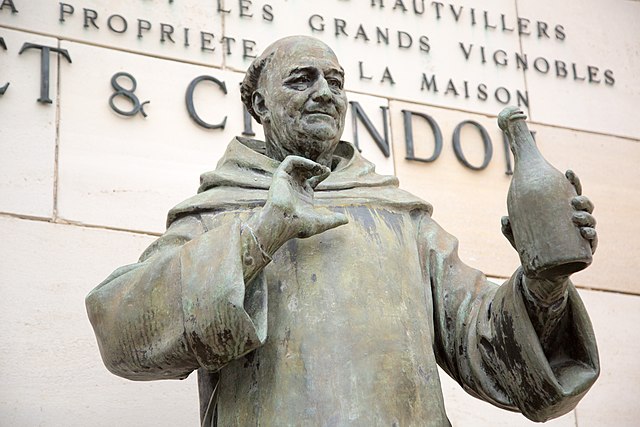The history of Champagne began when the Romans planted vineyards in this region of northeast France in the 5th century, or possibly earlier. Over centuries, Champagne evolved from being a pale, pinkish still wine to a sparkling wine. When Hugh Capet was crowned King of France in 987 at the cathedral of Reims, he started a tradition that brought successive monarchs to the region—with the local wine being on prominent display at the coronation banquets. The early wine of the Champagne region was a pale, pinkish wine made from Pinot noir.
A bottle of Champagne being used to christen the USS Shangri-La (CV-38) in 1944. Champagne has had a long history of being used in celebration of events such as the launching of ships.
The coronation of Hugh Capet in Reims started a tradition that would associate the region, and its wines, with royalty.
Even though he spent most of his career trying to rid his Champagne of bubbles, Dom Pérignon's pioneering techniques used to make white wine from red wine grapes would influence the development of modern sparkling Champagne.
While banished to England, the Marquis de Saint-Évremond did much to popularize Champagne in London society. While Saint-Évremond preferred his Champagne to be still, the sparkling version of Champagne soon became popular with the English.
A rosé is a type of wine that incorporates some of the color from the grape skins, but not enough to qualify it as a red wine. It may be the oldest known type of wine, as it is the most straightforward to make with the skin contact method. The pink color can range from a pale "onionskin" orange to a vivid near-purple, depending on the grape varieties used and winemaking techniques. Usually, the wine is labelled rosé in French, Portuguese, and English-speaking countries, rosado in Spanish, or rosato in Italian.
Sparkling rosé in the cave of Schramsberg Vineyards, in Napa, California, USA
A rosé wine from Washington state, USA
Many of the earliest red wines were closer in color to modern rosé since many of the early winemaking techniques involved pressing soon after harvest.
In the United States, a stuck fermentation while producing a red wine from Zinfandel would lead to the development of the popular rose-colored wine White Zinfandel.








